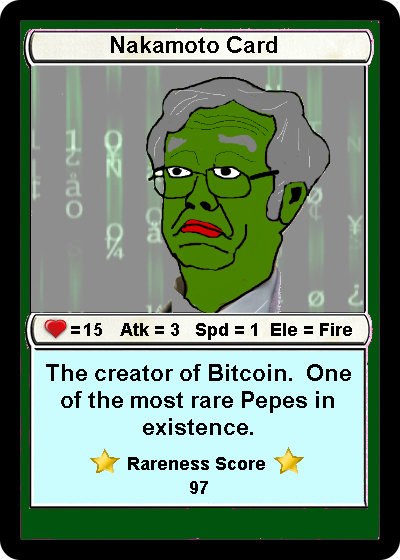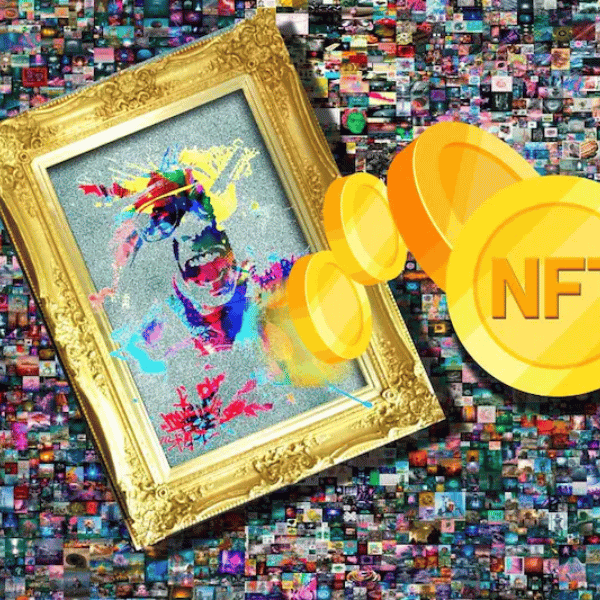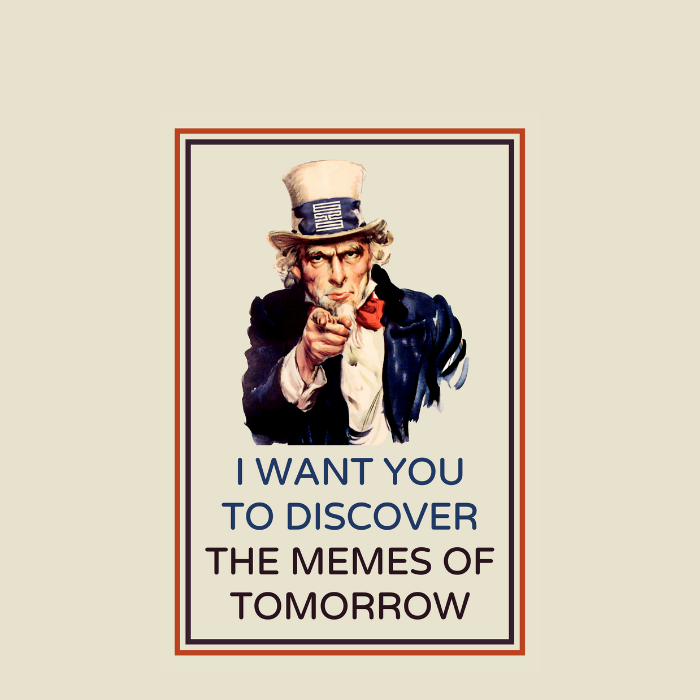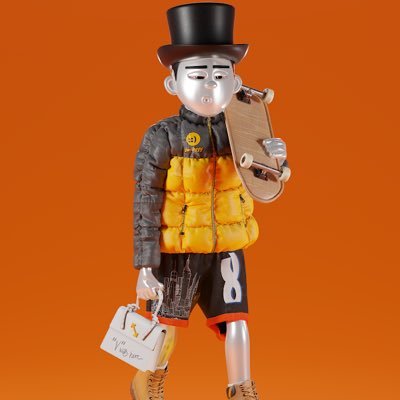Value of an NFT
Demand for each NFT (and the overall NFT collections) is driven by context around the creator, aesthetics, subjective preference, historical provenance, the rarity of traits presented in the work, and the edition size. In this article, we’ll take you through the past, highlighting 4 historically important NFT projects you need to know, their history and characteristics.
Rare Pepes – first meme immortalized on the blockchain
In 2005 Matt Furie created the character Pepe the Frog. Pepe, along with the phrase ‘feels good man’ gained traction as a meme, eventually making its way to 4chan in early 2009. Over the coming years Pepe made his way into the world, gaining popularity on social platforms amongst influencers and celebrities such as Katy Perry, Nicki Minaj and Donald Trump.

Rare Pepes were born on September 9th, 2016 when ‘Mike’ minted RAREPEPE, also known as the Nakamoto Card, on the Bitcoin-based network Counterparty; sparking the formation of a community led movement.

The Rare Pepe directory was subsequently created, officially establishing the Rare Pepe project. Submissions needed to adhere to basic formatting and originality guidelines and could not depict Pepe in explicitly hateful manners.
With the Rare Pepe directory established and a Telegram group of interested participants growing, the community needed a crypto wallet for storing their Rare Pepes and a safe market for trading them. Joe Looney thereby founded and launched Rare Pepe Wallet.
Rare Pepe Wallet represented the first user-friendly platform for storage and exchange of provably scarce digital collectibles on top of the blockchain.
Enabled by blockchain technology, the community continued to grow. A total of 1,774 cards were accepted into the Rare Pepe directory before it was closed for good in 2018. Today, the most valuable of all is the Series 1, Card 1 - the Nakamoto Card. This card pays homage to Satoshi Nakamoto, the mysterious creator of Bitcoin. Only 300 of these cards were ever minted, and holding one is the only way to gain entry into the coveted 300 Club.
As NFTs exploded in 2021 Pepe was revived. The Fake Rares project was created, revitalizing Pepes as a community driven art movement. As the popularity of NFTs skyrocketed, a protocol called Emblem Vault, enabling tokens issued on Bitcoin to be traded on Ethereum. Thereby, these rare and valuable cards could be sold on several NFT marketplaces which they have - for staggering amounts.
CryptoPunks – first historically significant NFT project to launch on a blockchain
In 2017, a revolutionary project hit the blockchain art scene – CryptoPunks. Created by Larva Labs, a collection of algorithmically generated NFTs was unlike anything the world had ever seen before. The collection originated out of Larva Labs algorithm that mixed together species, hair style, and accessories to create a randomized combination of visual outputs.

Each Punk, a 24x24 pixel art image was randomly generated, creating unique, rare and coveted characteristics. Upon launch, all 10,000 CryptoPunks could be claimed for free (paying only gas) by anyone with an Ethereum crypto wallet.
The impact of CryptoPunks on the NFT community cannot be overstated. This ground-breaking project directly inspired a new wave of pfp-projects, including the wildly popular Bored Ape Yacht Club. In many ways, CryptoPunks was the trailblazer that set the stage for today's vibrant and rapidly growing NFT landscape.
Despite the many NFT projects that have followed in its wake, CryptoPunks remains one of the most sought-after and exclusive collections in the NFT space. Punks are the ultimate status symbol, with Punks trading for hundreds of thousands of dollars and even climbing into the millions. It's not just collectors who are vying for these rare and valuable NFTs, either - major companies like Visa have also gotten in on the action by buying a CryptoPunk

The beauty of CryptoPunks lies in their historical provenance, endless variety and unique character. From hoodie-wearing punks to rare apes and alien traits, each Punk is a one-of-a-kind masterpiece that embodies the spirit of the NFT revolution. CryptoPunks is the perfect, but pricey way for anyone to own a piece of NFT history and join the exclusive club of Punks owners.
Autoglyphs – first on-chain generative art
Generative art, a process in which a computer program algorithmically generates unique artworks with a new combination of traits, however dates back to the 1960’s. The first-ever curated exhibition of generative art was hosted in 1965 in Stuttgart, showcasing works by Georg Nees.

Through blockchains and NFTs generative art has found its place as provenance and authenticity is encoded in the NFTs, allowing a long-term guarantee of ownership, provenance and edition size that is independent of any central authority.
Larval Labs, the team behind CryptoPunks launched Autoglyphs in April 2019 as the first on-chain generative art on the Ethereum blockchain. In Autoglyphs, the artwork exists within the smart contract itself that exists on the blockchain, it is literally on-chain.
Autoglyphs are being on-chain was revolutionary at the time of launch because traditionally, the actual image files associated with NFTs like RarePepe or CryptoPunks are stored in a database somewhere (off chain) meaning off of the blockchain. All Autoglyphs were created uniquely by code running on the Ethereum blockchain. Anyone who donated the fee to create an Autoglyph (0.2 ETH) to Larva Labs' chosen charity project, 350.org, could mint an Autoglyph while simultaneously becoming the first owner of an Autoglyph.

After 512 Autoglyphs had been minted, the generator which by code generated all Autoglyphs, shut itself down, forever. The historical provenance of being the first on-chain generative art on Ethereum and the scarcity of only 512 unique artworks has made Autoglyphs extremely valuable today.
Chromie Squiggle – first generative art project listed on Art Blocks
The founder of Art Blocks, Erick Calderon, created the genesis Art Blocks collection – Chromie Squiggle. Back in 2017 when Erick was dabbling with coding, projection mapping, 3D printing and generative art while working in the tile business, he learned about CryptoPunks and became fascinated by the idea of provable digital ownership.
It clicked to Erick that the blockchain was one of the best mediums for generative art distribution. Unlike CryptoPunks which presented all 10,000 outputs themselves, Erick realized you could use a smart contract to let buyers become part of the creation process through a random generative output the creator hadn’t even seen before the artwork is created.
The first Chromie Squiggle was created November 27 2021, and over the following weeks you could mint them for 0.035 ETH. Chromie Squiggle, an algorithmic edition of 10,000 NFTs, are on-chain with a script built into the smart contract that executes the moment a person mints a Chromie Squiggle. Not only that, all are animated and interactive.

Each Chromie Squiggle has a type, and some are rarer than others. In general, the rarer it is, the higher the price. Here are the Chromie Squiggle types in order of rarity: Normal (62.04%), Slinky (11.60%), Fuzzy (10.70%), Ribbed (7.70%), Bold (4.60%), Pipe (1.90%), Hyper (1.30%), Full Spectrum (0.40%) and Perfect Spectrum (0.20%).









Seven weeks after launch when 9,000 Chromie Squiggles had been minted, Snowfro decided to pause minting. The remaining 1,000 Chromie Squiggles would be saved for special events and for rewarding important contributions to Art Blocks. At the time of writing it remains 266 Chromie Squiggles to be minted.
Digital assets as store of value
Over the coming years, historically important NFT projects such as Rare Pepes, CryptoPunks, Autoglyphs, and Chromie Squiggles, can be expected to play an important role as a new class of store of value assets in digital format. Similar to what we experience today in the high-end physical art market.
One thing is for certain, digital assets, digital ownership and NFTs are rapidly emerging and will have an astounding impact on our future.





